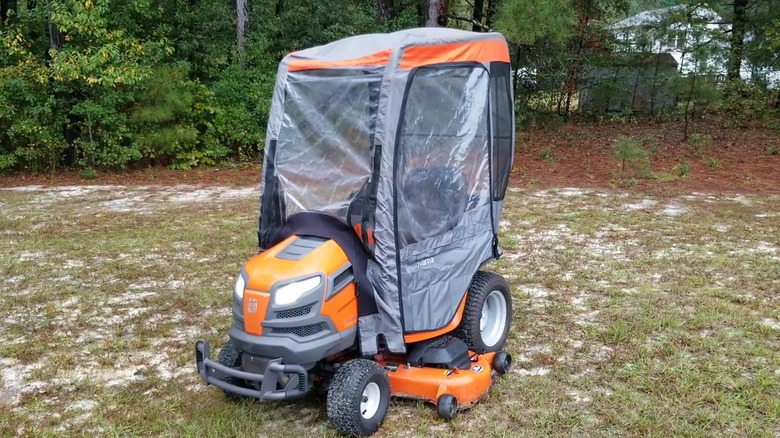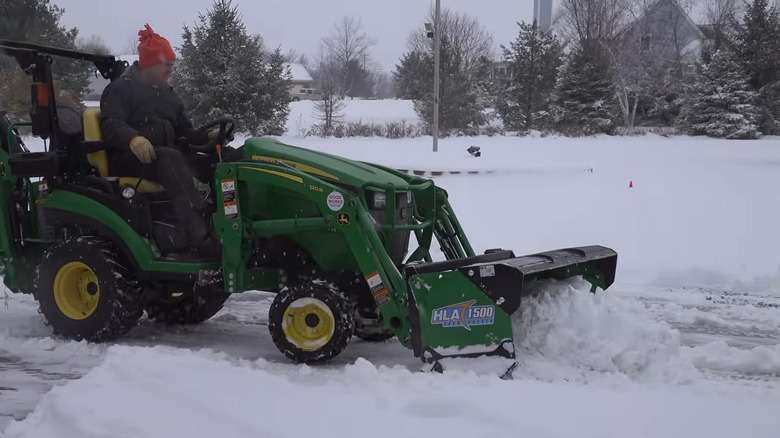5 Attachments For Your Riding Lawn Mower That Make Snow Removal A Breeze
As winter approaches, those of us in snowy locales are prepping for the fluff to come. And while this time of year is prime for beautiful snowfall, the dreaded chore of shoveling can make backs and arms achy just thinking about it. Despite life hacks that try to make the task easier, like timing shoveling for easy removal or using smart solutions to melt snow rather than shoveling, it's still an inevitable issue. However, there's an easy hack to make snow removal much lighter work: using your riding lawn mower as your secret weapon. By equipping your mower with snow removal attachments, like snow blades or snow blowers, you can avoid manually lifting any snow and instead sit comfortably and let the machine do the hard work.
The choice of attachment depends largely on the amount and type of snow you typically encounter in your geographic area, as well as your clearing needs. Some attachments, like snow blades, are fantastic for moving around complex curves and tight spaces, while others like snow blowers are best for wet or heavy snow. By utilizing the right attachments, you trade strained, sore muscles with the speed and convenience of machines.
A snow cab
Starting off the list with an attachment that works for many different snowy conditions, a snow cab is a great way to protect the rider from frigid winds, ultra-low temperatures, and active precipitation. Typically, snow cabs are either metal-framed, vinyl enclosures or hard-sided compartments that attach over the seat on the mower, providing the user protection against environmental factors. It not only provides shielding and comfort, it also helps enhance visibility and focus to make the task that much safer overall. Since sitting is an added bonus of a lawn mower attachment, make it comfortable for use.
Snow thrower
Snow throwers are a tried and true attachment for riding lawn mowers for those who typically get light to moderate, relatively fluffy snow. Often a single stage machine — meaning the attachment scoops up the snow and throws it from its shoot in one motion — this attachment clears snow by shooting it upwards of 15 feet away onto a bank. It's best for jobs needing some amount of finesse like driveways and walkways, so if you have a smaller lot, this no fuss upgrade is ideal for you.
Snow blower
Not to be confused with a snow thrower which utilizes single stage removal for snow fall of up to 10 inches, snow blower attachments remove snow in two stages. First, an auger breaks up the snow, then it's discharged out of a chute; this two step process makes removal faster and tackles more volume, meaning it works well in heavier snowfall. While some standalone models can run over $1,000, an attachment for your existing piece of equipment can achieve the same function for less. Just remember to abide by proper snow blowing safety protocols — the auger is sharp!
Front-mount snow blade/angle plow
For an even more precise method, consider a front-mounted snow blade attachment. Snow blades can get much closer to the ground than snow blowers can in moderate snow fall, and is ideal for use on narrow driveways and sidewalks since they can usually be angled to accommodate turns and curves. Like the name would suggest, front-mounted snow blades sit at the front of your mower making it easy to maneuver. With snow blades, you can push the snow forward, then angle the snow onto a snow bank on either side of you for crisp removal.
Front mount snow pusher/box
While operating under the same basic premise as snow blades, snow pushers have two fixed shields on either end of the plow, creating a box to help contain and pile up the snow. Standard snow blades simply push and angle the snow out of the way, creating banks on the sides or in front of the machine. Instead, snow pushers gather large volumes of snow quickly across wide-open spaces, like expansive lots, to deposit into controlled high piles. The average snow blade, however, is better suited for narrower areas that require nuanced handling and side-casting.





